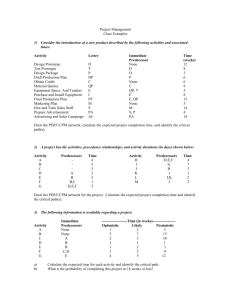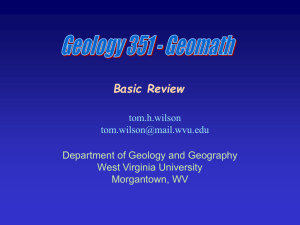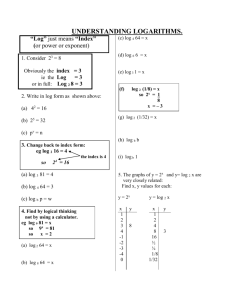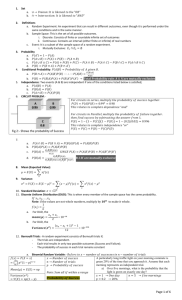1/2 of - West Virginia University
advertisement
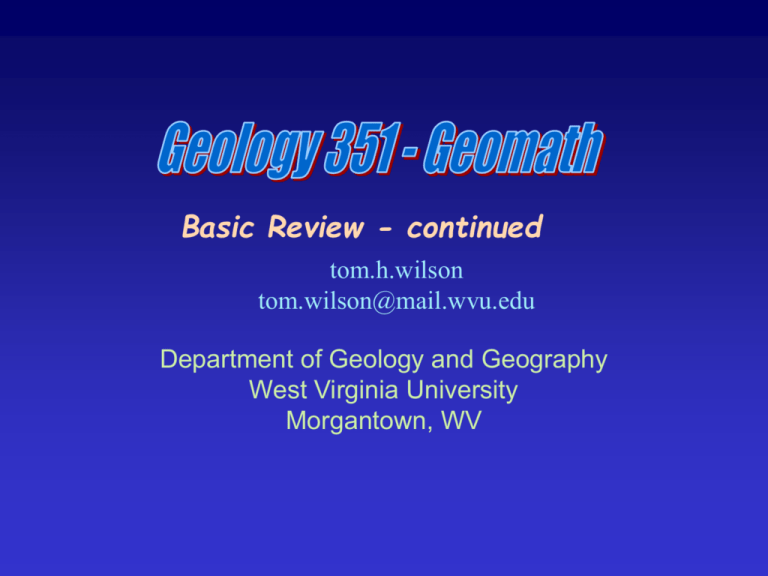
Basic Review - continued tom.h.wilson tom.wilson@mail.wvu.edu Department of Geology and Geography West Virginia University Morgantown, WV In geology we’re usually trying to come up with a mathematical model that explains or characterizes a geologic process. One equation rarely explains the variety of behaviors associated with even a single geological process. And one way or another we are always making some assumptions in the approach we choose to estimate things. Recent Sedimentation Record - North Sea 16000 14000 Age (years) 12000 10000 8000 6000 4000 2000 0 10 510 1010 Depth (cm) 1510 2010 This is a quadratic equation. The general form of a quadratic equation is y ax 2 bx c Quadratics 125 y 2 x 2 10 x 20 75 y 2x 2 Y 25 y 3x 2 60 -25 -75 -6 -4 -2 0 X 2 4 6 One equation differs form that used in the text We see that the variations of T with Depth are nearly linear in certain regions of the subsurface. In the upper 100 km the relationship T 20 x 10 provides a good approximation. 5000 From 100-700km the relationship T 1.25 x 1017 works well. 4000 3000 T 2000 Can we come up with an equation that will fit the variations of temperature with depth - for all depths? Let’s try a quadratic. 1000 0 0 1000 2000 3000 4000 Depth (km) 5000 6000 7000 The quadratic relationship plotted below is just one possible relationship that could be derived to explain the temperature depth variations. T (1.537 x10 4 ) x 2 1.528 x 679 .77 5000 4000 3000 T 2000 1000 0 0 1000 2000 3000 4000 Depth (km) 5000 6000 7000 These are members of the general class of functions referred to as polynomials. A polynomial is an equation that includes x to the power 0, 1, 2, 3, etc. The straight line y mx b is referred to as a first order polynomial. The order corresponds to the highest power of x present in the equation - in the above case the highest power is 1. 2 y ax bx c is a second order The quadratic Polynomial, and the equation y ax bx n n 1 cx n2 ... a0 is an nth order polynomial. 5000 4000 4000 3000 3000 O T( C) 5000 T 2000 2000 1000 1000 0 0 1000 2000 3000 4000 Depth (km) 5000 6000 7000 0 0 1000 2000 3000 4000 Depth (km) Can we obtain more accurate representations? 5000 6000 7000 Here is another 4th order polynomial which in this case attempts to fit the near-surface 100km. Notice that this 4th order equation (redline plotted in graph) has three bends or turns. T 1.289 x10 11 d 4 1.99 x10 7 x3 0.00113 x 2 3.054 x 394 .41 th 4 Polynomial 5000 4000 T 3000 2000 1000 0 0 1000 2000 3000 4000 Depth (km) 5000 6000 7000 In sections 2.5 and 2.6 Waltham reviews negative and fractional powers. The graph below illustrates the set of curves that result as the exponent p in y ax p c Power Laws is varied from 2 to -2 in 0.25 steps, and c equals 0. Note that the negative powers rise quickly up along the y axis for values of x less than 1 and that y rises quickly with increasing x for p greater than 1. 2 2 4 2 What is 0.01 X -2 1000 800 Y 600 X -1.75 400 X 200 0 1 2 3 x ? 2 X 0 What is 0.01 ? 2 1200 4 5 1.75 Power Laws - A power law relationship relevant to geology describes the variations of ocean floor depth as a function of distance from a spreading 1/ 2 ridge (x). d ax d 0 Ocean Floor Depth 0 1 Spreading Ridge 2 D (km) 3 4 5 0 200 400 600 800 1000 X (km) What physical process do you think might be responsible for this pattern of seafloor subsidence away from the spreading ridges? Section 2.7 Allometric Growth and Exponential Functions Allometric - differential rates of growth of two measurable quantities or attributes, such as Y and X, related through the equation Y=abX - Examples: Age vs. Depth, radioactive decay, earthquake frequency and magnitude, porosity and depth relationships … This relationship is not linear. A straight line does a poor job of passing through the data points. The slope (gradient or rate of change) decreases with increased depth. 0.6 Porosity 0.5 Just as an aside, what does the relationship A=kZ imply about porosity variation as a function of depth? 0.4 0.3 0.2 0.1 0.0 -0.1 0 1 2 3 4 5 Draw a graph Depth Waltham generates this data using the following relationship. 0.6 x 2 z These compaction effects make the age-depth relationship non-linear. The same interval of depth D at large depths will include sediments deposited over a much longer period of time than will a shallower interval of the same thickness. Porosity might vary with depth more like that shown in the table below Depth (km) 0 1 2 3 4 Porosity () 0.6 0.3 0.15 0.075 0.0375 Over the range of depth 0-4 km, the porosity decreases from 60% to 3.75%! 0.6 Porosity 0.5 0.4 0.3 0.2 0.1 0.0 0.00 0.50 1.00 1.50 2.00 Depth 2.50 3.00 3.50 4.00 0.6 x 2 z This equation assumes that the initial porosity (0.6) decreases by 1/2 from one kilometer of depth to the next. Thus the porosity () at 1 kilometer is 2-1 or 1/2 that at the surface (i.e. 0.3), (2)=1/2 of (1)=0.15 (I.e. =0.6 x 2-2 or 1/4th of the initial porosity of 0.6. Equations of the type y ab cx are referred to as allometric growth laws or exponential functions. In the equation y ab cx 0.6 x 2 a=? a=0.6 b=? b=2 c=? c= -1 z The constant b is referred to as the base. Recall that in relationships like y=10a, a is the power to which the base 10 is raised in order to get y. Logarithms Above, when we talked about functions like y ab cx and y a10 cx b and 10 are what we refer to as bases. These are constants and we can define any other number in terms of these constants raised to a certain power. Given any number y, we can express y as 10 raised to some power x Thus, given y =100, we know that x must be equal to 2. i.e. y 10 x y 10 x By definition, we also say that x is the log of y, and can write log y log 10 x x So the powers of the base are logs. “log” can be thought of as an operator like x and which yields a certain result. Unless otherwise noted, the operator “log” is assumed to represent log base 10. So when asked what is log y, where y 45 We assume that we are asking for x such that 10 x 45 One of the most commonly used “Richter magnitude” scales determines the magnitude of shallow earthquakes from surface waves according to the following equation m log10 A 1.66 log 3.3 T where T is the period in seconds, A the maximum amplitude of ground motion in m (10-6 meters) and is the epicentral distance in degrees between the earthquake and the observation point. We’ve already worked with three bases - 2, 10 and e. Whatever the base, the logging operation is the same. log 5 10 asks what is the power that 5 must be raised to to get 10. log 5 10 ? How do we find these powers? log10 10 log 5 10 log10 5 1 log 5 10 1.431 0.699 thus 51.431 10 In general, log10 (number) log base (some number) log10 base or log b a log10 (a) log10 b Try the following on your own log 3 7 log10 (7) ? log10 3 log 8 8 log 7 21 log 4 7 As noted above log 10 is often writ ten as log, with no subscript log10 is referred to as the common logarithm log e is often writ ten as ln. thus log e 8 ln8 2.079 loge or ln is referred to as the natural logarithm. All other bases are usually specified by a subscript on the log, e.g. log 5 or log 2 , etc. Finish reading Chapters 1 and 2 (pages 1 through 38) of Waltham and begin reading through Chapter 3. After we finish our basic review, we will learn how to use Excel a scientific computing and graphing software package to solve some problems related to the materials we’ve just covered in Chapters 1 and 2.
